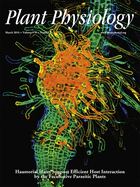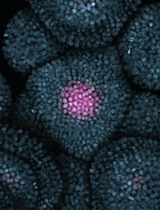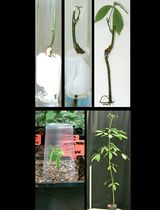- EN - English
- CN - 中文
Electro-fusion of Gametes and Subsequent Culture of Zygotes in Rice
水稻配子的电融合及后续合子培养
发布: 2016年12月20日第6卷第24期 DOI: 10.21769/BioProtoc.2074 浏览次数: 12498
评审: Renate WeizbauerYvon JaillaisAlizée Malnoe
Abstract
Electro-fusion system with isolated gametes has been utilized to dissect fertilization-induced events in angiosperms, such as egg activation, zygote development and early embryogenesis, since the female gametophytes of plants are deeply embedded within ovaries. In this protocol, procedures for isolation of rice gametes, electro-fusion of gametes, and culture of the produced zygotes are described.
Keywords: Egg cell (卵细胞)Background
Fertilization and subsequent events in angiosperms, such as embryogenesis and endosperm development, occur in the embryo sac deeply embedded in ovular tissue (Nawaschin, 1898; Guignard, 1899; Russell, 1992; Raghavan, 2003). Therefore, isolated gametes have been used for in vitro fertilization (IVF) system to observe and analyze fertilization and postfertilization processes (reviewed in Wang et al., 2006). The IVF system used for angiosperms includes a combination of three basic micro-techniques: (i) the isolation and selection of male and female gametes; (ii) the fusion of pairs of gametes and (iii) single cell culture (Kranz, 1999). Procedures for isolating viable gametes have been established in a wide range of plant species, including monocotyledonous and dicotyledonous plants (reviewed in Kranz, 1999 and in Okamoto, 2011). The isolated gametes can be fused electrically (Kranz et al., 1991; Uchiumi et al., 2006 and 2007) or chemically using calcium (Faure et al., 1994; Kranz and Lörz, 1994; Khalequzzaman and Haq, 2005), polyethyleneglycol (Sun et al., 1995; Tian and Russell, 1997) or bovine serum albumin (Peng et al., 2005), as the gametes are generally protoplasts. Although gametes can be fused using these different procedures, only zygotes produced by electro-fusion are only known to divide and develop into embryo-like structures and plantlets. A complete IVF system was developed by Kranz and Lörz (1993) using maize gametes and electrical fusion, and, to take advantage of the abundant resources stemming from rice research, a rice IVF system was also established by Uchiumi et al. (2007). By the use of these electro-fusion based IVF systems, post-fertilization events, such as karyogamy (Faure et al., 1993; Ohnishi et al., 2014), egg activation and zygotic development (Kranz et al., 1995; Nakajima et al., 2010; Sato et al., 2010), paternal chromatin decondensation in zygote nucleus (Scholten et al., 2002), the microtubular architecture in egg cells and zygotes (Hoshino et al., 2004), fertilization-induced/suppressed gene expression (Okamoto et al., 2005), epigenetic resetting in early embryos (Jahnke and Scholten, 2009), have been successfully observed and investigated. Moreover, polyspermic triploid zygotes were produced by the modification of the rice IVF system and the triploid zygotes were grown into triploid mature plants (Toda et al., 2016). The rice IVF system described here might become an important technique for generating new cultivars with desirable characters as well as for investigating post fertilization events.
Materials and Reagents
- Coverslips (24 x 40 mm) (Thermo Fisher Scientific, Fisher Scientific, catalog number: 125485J ) (siliconized at the edges with 5% dichlorodimethylsilane in 1,1,1-trichloroethane, see Note 3)
- Glass capillaries made from 50 μl aspirator tubes (Drummond Scientific, catalog number: 2-000-050 ) (Figures 1A and 1B, Video 1; see Note 4)
- Manual handling injector (ST Science, type UJB)
- Non-treated plastic dishes with diameter of 3.5 cm (Iwaki, catalog number: 1000-035 )
- Razor blade
- Millicell-CM inserts, diameter 12 mm (EMD Millipore, catalog number: PICM01250 )
- Glass needles (2 mm diameter) with fine tips
- Rice plants (Oryza sativa L. cv. Nipponbare) (see Note 1)
- Feeder cells: rice suspension cell culture (Line Oc, provided by RIKEN Bio-Resource Center, Tsukuba, Japan) (see Note 2)
- Mineral oil (Sigma-Aldrich, catalog number: M8410-100ML )
- Mannitol (Wako Pure Chemicals Industries, catalog number: 133-00845 )
- Absolute ethanol (Wako Pure Chemicals Industries, catalog number: 057-00451 )
- 370 mosmol/kg H2O (330 mM) mannitol solution (autoclaved)
- 450 mosmol/kg H2O (385 mM) mannitol solution (autoclaved)
- 520 mosmol/kg H2O (430 mM) mannitol solution (autoclaved)
- CHU (N6) basal salt mixture (Sigma-Aldrich, catalog number: C1416 )
- Na2MoO4.2H2O (Wako Pure Chemicals Industries, catalog number: 514-30001 )
- CoCl2·6H2O (Wako Pure Chemicals Industries, catalog number: 036-03682 )
- CuSO4·5H2O (Wako Pure Chemicals Industries, catalog number: 039-19385 )
- Retinol (Sigma-Aldrich, catalog number: R7632 )
- Calciferol (Wako Pure Chemicals Industries, catalog number: 039-00291 )
- Biotin (Wako Pure Chemicals Industries, catalog number: 023-08711 )
- Thiamin·HCl (Nacalai Tesque, catalog number: 36319-82 )
- Nicotinic acid (Sigma-Aldrich, catalog number: N4126 )
- Pyridoxine·HCl (Wako Pure Chemicals Industries, catalog number: 163-05402 )
- Choline chloride (Sigma-Aldrich, catalog number: C7527 )
- Ca-pantothenate (Wako Pure Chemicals Industries, catalog number: 031-14161 )
- Riboflavin (Wako Pure Chemicals Industries, catalog number: 180-00171 )
- 2,4-D (Wako Pure Chemicals Industries, catalog number: 040-18532 )
- Cobalamine (Sigma-Aldrich, catalog number: V2876 )
- p-aminobenzoic acid (Sigma-Aldrich, catalog number: 100536 )
- Folic acid (Wako Pure Chemicals Industries, catalog number: 062-01801 )
- Ascorbic acid (Wako Pure Chemicals Industries, catalog number: 012-04802 )
- Malic acid (Sigma-Aldrich, catalog number: M1000 )
- Citric acid (Sigma-Aldrich, catalog number: 251275 )
- Fumaric acid (Wako Pure Chemicals Industries, catalog number: 069-00652 )
- Na-pyruvate (Tokyo Chemical Industry, catalog number: P0582 )
- Glutamine (Wako Pure Chemicals Industries, catalog number: 078-00525 )
- Casein hydrolysate (BD, catalog number: 22 3050 )
- Myo-inositol (Wako Pure Chemicals Industries, catalog number: 094-00281 )
- Glucose (Wako Pure Chemicals Industries, catalog number: 049-31165 )
- MS salt (Wako Pure Chemicals Industries, catalog number: 392-00591 )
- MS vitamin (Sigma-Aldrich, catalog number: M7150 )
- Sucrose (Wako Pure Chemicals Industries, catalog number: 196-00015 )
- Sorbitol (Wako Pure Chemicals Industries, catalog number: 198-03755 )
- 1-naphthaleneacetic acid (Nacalai Tesque, catalog number: 23628-32 )
- Kinetin (Sigma-Aldrich, catalog number: K3378 )
- Gelrite (Wako Pure Chemicals Industries, catalog number: 075-05655 )
- Dichlorodimethylsilane (Tokyo Chemical Industry, catalog number: D0358 )
- 1,1,1-trichloroethane (Tokyo Chemical Industry, catalog number: T0380 )
- Zygote culture medium (see Recipes)
- Regeneration media (see Recipes)
- Rooting media (see Recipes)
Equipment
- Stereo microscope (OLYMPUS, model: SZ61 )
- Inverted microscope (OLYMPUS, model: IX-71 or IX-73 )
- Forceps
- Electrofusion apparatus (Nepa Gene, model: ECFG21 )
- Manipulator (NARISHIGE, model: M-152 ) with a double pipette holder (NARISHIGE, model: HD-21 )
- Electrodes (Nepa Gene, model: CUY5100Ti100 ) fixed to the pipette holder
- Sliding stage for the insertion of a coverslip and a plastic dish
- Environmental chambers
- Charge-coupled device camera (Pixcera, model: Penguin 600CL )
Software
- InStudio software (Pixcera)
Procedure
文章信息
版权信息
© 2016 The Authors; exclusive licensee Bio-protocol LLC.
如何引用
Readers should cite both the Bio-protocol article and the original research article where this protocol was used:
- Toda, E., Ohnishi, Y. and Okamoto, T. (2016). Electro-fusion of Gametes and Subsequent Culture of Zygotes in Rice. Bio-protocol 6(24): e2074. DOI: 10.21769/BioProtoc.2074.
-
Toda, E., Ohnishi, Y. and Okamoto, T. (2016). Development of polyspermic rice zygotes. Plant Physiol 171(1): 206-214.
分类
植物科学 > 植物发育生物学 > 综合
细胞生物学 > 细胞工程 > 细胞融合技术
您对这篇实验方法有问题吗?
在此处发布您的问题,我们将邀请本文作者来回答。同时,我们会将您的问题发布到Bio-protocol Exchange,以便寻求社区成员的帮助。
Share
Bluesky
X
Copy link












